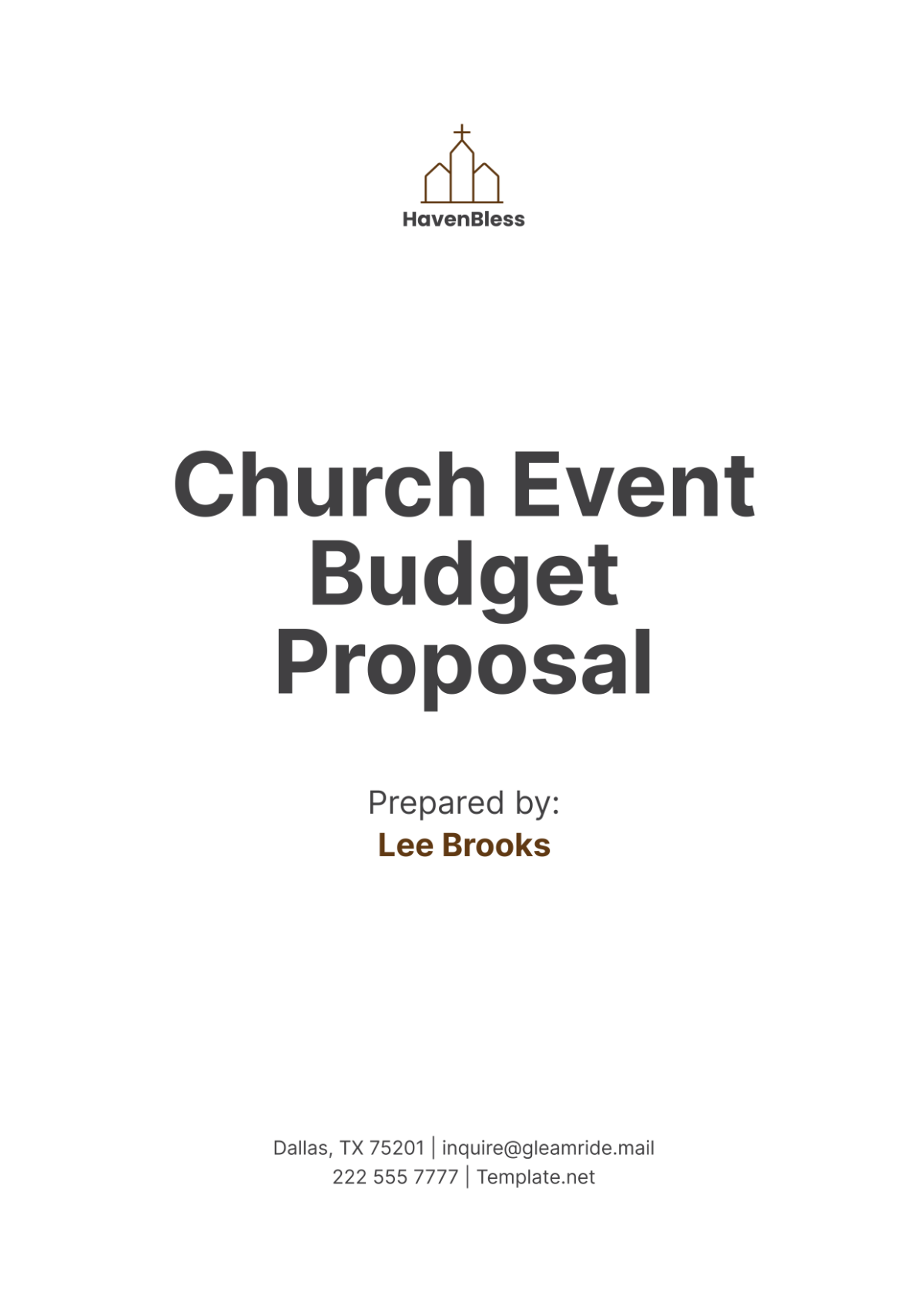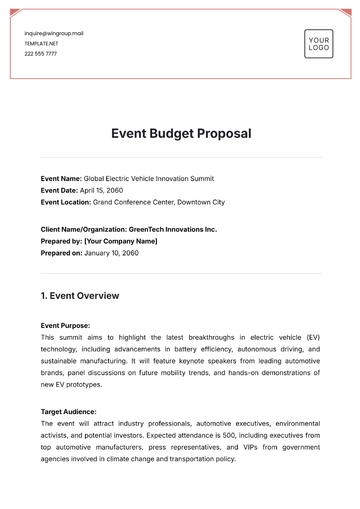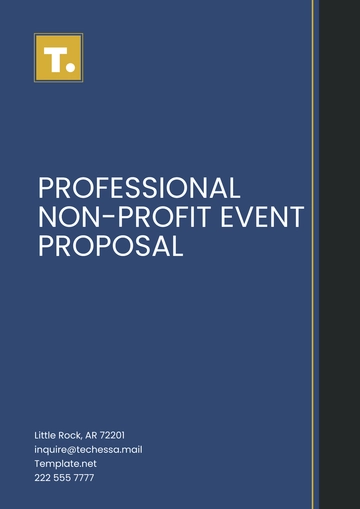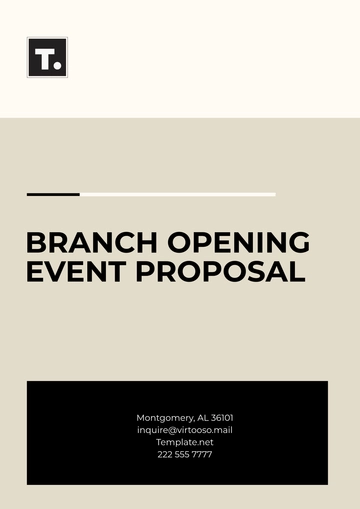Free Church Event Budget Proposal

I. Introduction
The purpose of this proposal is to provide a financial plan for the [Your Company Name]'s charity drive scheduled for [2050]. This drive aims to raise funds and collect donations to support various local and global charitable causes, fostering community involvement and making a meaningful impact. The proposal details the budget, funding sources, risk management strategies, and schedule for the charity drive.
A. Scope
This proposal covers all aspects of the charity drive's financial management, including budget allocation, funding sources, risk management, and event scheduling. It ensures that all necessary resources are accounted for and provides a structured approach to executing a successful charity drive.
II. Objectives of the Charity Drive
Establishing clear objectives is essential for guiding the planning and execution of the charity drive. These objectives provide a framework for evaluating the success of the event and ensuring that it meets its intended goals.
A. Fundraising Goals
Financial Target: Set a specific financial target to ensure the charity drive's success. This target represents the total amount of funds that need to be raised to support the chosen causes effectively.
Donation Types: Identify and specify the types of donations sought, including monetary contributions, in-kind donations, and services. This helps in targeting the appropriate donors and resources.
Donor Engagement: Develop strategies to engage with potential donors, including personalized appeals, online campaigns, and public recognition. Effective engagement increases the likelihood of achieving the fundraising goals.
Campaign Promotion: Implement promotional activities, such as social media campaigns, flyers, and community outreach, to raise awareness and generate interest in the charity drive.
B. Community Involvement
Volunteer Participation: Recruit volunteers to assist with various aspects of the charity drive, including event planning, setup, and execution. Volunteers are essential for the smooth operation and success of the drive.
Community Outreach: Engage with community members and organizations to encourage their participation and support. Outreach efforts build a sense of community involvement and broaden the drive's impact.
Partnerships: Establish partnerships with local businesses and other organizations to enhance the reach and effectiveness of the charity drive. Partnerships can provide additional resources and support.
Educational Components: Offer educational materials and sessions to inform participants about the charitable causes being supported. Education fosters a deeper understanding of the drive's purpose and motivates greater involvement.
C. Impact Measurement
Tracking Contributions: Implement a system for monitoring and recording all contributions received during the drive. Accurate tracking ensures transparency and helps in assessing the drive's success.
Evaluating Outcomes: Assess the results of the charity drive by analyzing the funds raised, community engagement, and overall impact. Evaluation helps in understanding the drive's effectiveness and areas for improvement.
Reporting Results: Prepare a detailed report summarizing the outcomes of the drive, including financial summaries and impact assessments. Reporting provides accountability and demonstrates the drive's success.
Feedback Collection: Collect feedback from participants, volunteers, and donors to gather insights and identify areas for improvement. Feedback helps in refining future charity drives and enhancing overall effectiveness.
III. Budget Overview
A well-structured budget is crucial for managing the financial aspects of the charity drive. It ensures that all expenses are accounted for and that resources are allocated efficiently.
Category | Estimated Cost |
|---|---|
Venue Rental | $2,500 |
Marketing and Promotion | $3,000 |
Event Supplies | $1,500 |
Volunteer Support | $1,000 |
Fundraising Materials | $1,000 |
Charity Distribution | $5,000 |
Miscellaneous | $500 |
Total Estimated Budget | $14,500 |
This budget provides a breakdown of the estimated costs associated with the charity drive. It ensures that all necessary expenses are accounted for and includes a reserve fund to manage unexpected costs. Proper budgeting helps in maintaining financial control and achieving the drive's goals.
IV. Funding Sources
Identifying and securing funding sources is essential for covering the costs of the charity drive and ensuring that sufficient financial resources are available. This section outlines potential funding sources and strategies for securing financial support.
A. Donor Contributions
Individual Donors: Solicit contributions from individuals through direct appeals, online campaigns, and personal requests. Individual donations are a primary source of funding for the charity drive.
Corporate Sponsorships: Seek sponsorships from local businesses and corporations to provide financial backing and support for the event. Corporate sponsors can also enhance the drive's visibility and credibility.
Fundraising Events: Organize additional fundraising events, such as auctions or benefit dinners, to generate additional revenue and engage the community. These events can complement the main charity drive.
Grants: Apply for grants from foundations or government agencies that support charitable initiatives. Grants provide a significant source of funding and can help in covering substantial expenses.
B. In-Kind Donations
Goods and Services: Request donations of goods and services that can be used during the event, such as catering, decorations, and event supplies. In-kind donations reduce overall costs and enhance the drive's offerings.
Volunteers: Engage volunteers who can contribute their time and skills to assist with planning and executing the charity drive. Volunteers play a crucial role in ensuring the drive's success.
Partnership Contributions: Leverage partnerships with local organizations to secure in-kind contributions and support for the drive. Partnerships can provide additional resources and support.
Community Support: Encourage community members to contribute items or services that can be used to support the drive's objectives. Community support helps in building a sense of collective effort.
V. Risk Management
Effective risk management is essential to anticipate and address potential issues that may arise during the charity drive. This section outlines strategies and procedures for managing risks and ensuring the smooth execution of the event.
A. Risk Assessment
Financial Risks: Assess and manage financial risks, such as budget overruns or funding shortfalls, by closely monitoring expenses and securing additional funding if needed. Effective financial management prevents budgetary issues.
Operational Risks: Identify and address operational risks, including logistical challenges or equipment failures, by developing contingency plans and ensuring that all necessary resources are in place. This helps in maintaining event continuity.
Health and Safety Risks: Evaluate and manage health and safety risks, such as accidents or medical emergencies, by providing first aid support and ensuring that emergency procedures are established. Ensuring safety is a priority.
Reputational Risks: Address reputational risks, such as negative publicity or complaints, by maintaining transparency, addressing concerns promptly, and handling communications professionally. Managing reputation is crucial for future events.
B. Emergency Procedures
Emergency Contacts: Maintain a list of emergency contacts, including local authorities, medical services, and venue management, for quick access in case of emergencies. This ensures a swift response to any incidents.
First Aid: Ensure that first aid kits are available and that key staff members are trained in basic first aid and emergency response procedures. This preparedness supports effective handling of medical situations.
Evacuation Plans: Develop and communicate clear evacuation plans, including designated exit routes and assembly points, to ensure the safety of all participants in case of an emergency. Effective evacuation plans minimize risk.
Incident Reporting: Establish a procedure for reporting and documenting incidents, such as accidents or security breaches, to ensure that issues are addressed and lessons are learned. Documentation supports continuous improvement.
VI. Schedule of Events
An event schedule is essential for organizing and managing the charity drive. It provides a structured timeline for all activities and ensures that the event proceeds according to plan.
Date | Time | Activity |
|---|---|---|
[Month Day, Year] | 10:00 AM - 12:00 PM | Opening Ceremony |
[Month Day, Year] | 12:00 PM - 2:00 PM | Charity Fair |
[Month Day, Year] | 2:00 PM - 4:00 PM | Volunteer Orientation |
[Month Day, Year] | 9:00 AM - 12:00 PM | Fundraising Activities |
[Month Day, Year] | 1:00 PM - 3:00 PM | Community Engagement |
[Month Day, Year] | 10:00 AM - 12:00 PM | Donation Collection |
[Month Day, Year] | 1:00 PM - 3:00 PM | Closing Ceremony |
This event schedule outlines the timing and content of key activities during the charity drive, ensuring that each phase of the event is well-organized and executed. The schedule facilitates smooth transitions between activities and helps maintain a structured flow throughout the drive.
The charity drive proposed for [2050] represents a significant opportunity to support meaningful causes and strengthen community engagement. This proposal provides a comprehensive framework for the successful execution of the charity drive, ensuring that all aspects are managed effectively and that the event delivers valuable benefits to those in need.
- 100% Customizable, free editor
- Access 1 Million+ Templates, photo’s & graphics
- Download or share as a template
- Click and replace photos, graphics, text, backgrounds
- Resize, crop, AI write & more
- Access advanced editor
Manage finances efficiently with the Church Event Budget Proposal Template from Template.net. This editable and customizable template provides a detailed layout for planning and presenting the budget for church events. The template includes sections for income projections, expense categories, funding sources, and financial controls, ensuring comprehensive and transparent budget planning.
You may also like
- Business Proposal
- Research Proposal
- Proposal Request
- Project Proposal
- Grant Proposal
- Photography Proposal
- Job Proposal
- Budget Proposal
- Marketing Proposal
- Branding Proposal
- Advertising Proposal
- Sales Proposal
- Startup Proposal
- Event Proposal
- Creative Proposal
- Restaurant Proposal
- Blank Proposal
- One Page Proposal
- Proposal Report
- IT Proposal
- Non Profit Proposal
- Training Proposal
- Construction Proposal
- School Proposal
- Cleaning Proposal
- Contract Proposal
- HR Proposal
- Travel Agency Proposal
- Small Business Proposal
- Investment Proposal
- Bid Proposal
- Retail Business Proposal
- Sponsorship Proposal
- Academic Proposal
- Partnership Proposal
- Work Proposal
- Agency Proposal
- University Proposal
- Accounting Proposal
- Real Estate Proposal
- Hotel Proposal
- Product Proposal
- Advertising Agency Proposal
- Development Proposal
- Loan Proposal
- Website Proposal
- Nursing Home Proposal
- Financial Proposal
- Salon Proposal
- Freelancer Proposal
- Funding Proposal
- Work from Home Proposal
- Company Proposal
- Consulting Proposal
- Educational Proposal
- Construction Bid Proposal
- Interior Design Proposal
- New Product Proposal
- Sports Proposal
- Corporate Proposal
- Food Proposal
- Property Proposal
- Maintenance Proposal
- Purchase Proposal
- Rental Proposal
- Recruitment Proposal
- Social Media Proposal
- Travel Proposal
- Trip Proposal
- Software Proposal
- Conference Proposal
- Graphic Design Proposal
- Law Firm Proposal
- Medical Proposal
- Music Proposal
- Pricing Proposal
- SEO Proposal
- Strategy Proposal
- Technical Proposal
- Coaching Proposal
- Ecommerce Proposal
- Fundraising Proposal
- Landscaping Proposal
- Charity Proposal
- Contractor Proposal
- Exhibition Proposal
- Art Proposal
- Mobile Proposal
- Equipment Proposal
- Student Proposal
- Engineering Proposal
- Business Proposal





























